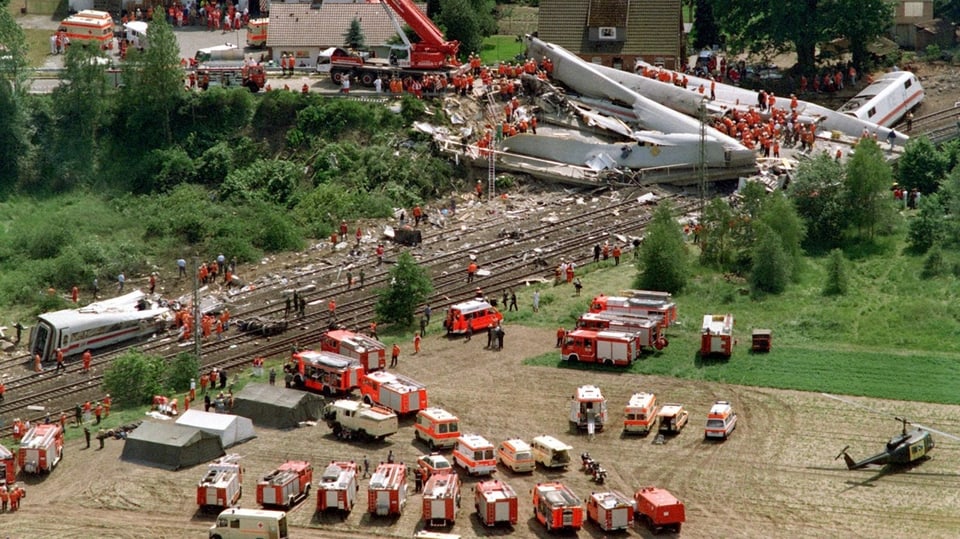
Since June 3, 1998, the small town of Eschede on the edge of the Lüneburg Heath has been inextricably linked to Germany’s worst train crash. 101 people died then. Relatives and helpers still bear the brunt of its effects and memories today.
It’s an early summer day, and the sun is peeking through the branches of the cherry trees. 101 After the accident, a tree was planted for each victim.
As far as I’m concerned there’s a life before escapades and a life after escapades. And life after Eschede was not good.
Udo Bach carefully descends the steep stairs to the grove. Since June 3, 1998, he is partially paralyzed on his left side and walks with a cane. “I have a life before Eschede and a life after Eschede. And life after Eschede is not good,” says Laconiaga, 55.
Accident timeline
On June 3, 1998, Udo Bauch was sitting in carriage 11 of the Intercity-Express ICE, traveling from Munich to Hamburg at a speed of 200 km/h. Six kilometers from Escade in Lower Saxony, a wheel tire burst under the third car. The metal part wedged itself into the wheel bogie and bored into the floor of the car.

Purana:
Horror film: Seven carriages of “Wilhelm Konrad Röntgen” push together like an accordion.
Keystone/DBA/Ingo Wagner
200 meters before the southern outskirts of Eschede, a stuck wheel tire hit the first set of points, causing Bogey to derail and switch to the second set of points. The rear of the car was guided onto the branch road and hit the pillars of the road bridge at a speed of 200 kilometers per hour.
The first four wagons pass under the collapsing bridge. Cars 5 and 6, the dining car and the first class car, are crushed under 200 tons of concrete. The following seven cars are pushed together in seconds like an accordion.
Massive rescue operation
Minutes after the accident, the first residents are on the scene, trying to rescue the injured from the wedged, piled wagons. A distress alert is triggered.

Purana:
Hundreds of rescuers are trying to rescue victims of the train crash from the wreckage of the crashed ICE 884.
Keystone/DBA/Ingo Wagner
At that point District Fire Chief Gerd Backberg rushed in from a nearby cell and coordinated the rescue as overall operations manager. “We accepted all kinds of assistance from neighboring counties and professional fire brigades as far as Hamburg because we didn’t know how many people were on the train at the time.”
A total of 1900 rescue personnel, 350 vehicles and 39 helicopters are involved in the rescue operation. But for 101, any help came too late, and 105 were injured, some seriously.
Apologies for the delay
Relatives and survivors sued Deutsche Bahn, but the cases were dropped in 2003 and a perpetrator was never found. “It’s a room for victims,” says Udo Bach.
For me there is no compromise with railways because the suffering, the daily pain is too much.
The whole thing was as hard to digest as the first apology from the train operator – 15 years after the accident. “I have no compromise with the train, because the suffering, the daily pain, is too great.”
At least lessons were learned from the tragedy. Additional emergency exit windows have been installed in ICE trains, firefighting equipment has been upgraded. Eschede was also the initial spark for rescue workers’ aftercare. Because in such important cases, even helpers need psychological and pastoral support.
Eschede is more than this misfortune, we are back to normal.
For Eschede, June 3 has been a fixed date in the calendar for 25 years. However, Mayor Heinrich Lange places great importance on not letting his village suffer the tragedy: “The escapades are more than this misfortune, we are back to normal.” Remembrance will always have a permanent place in Eschede.

“Wannabe pop culture fanatic. Zombie advocate. Entrepreneur. Internet evangelist. Alcohol fanatic. Typical travel buff.”




More Stories
User Insights on Using Slot Winner APK Effectively
Choosing the Right Quality Management Software for Your Industry
Astronauts will be stuck in the ISS for months